INFINITI QX30 2018 Warranty Information Booklet
Manufacturer: INFINITI, Model Year: 2018, Model line: QX30, Model: INFINITI QX30 2018Pages: 60, PDF Size: 0.24 MB
Page 41 of 60
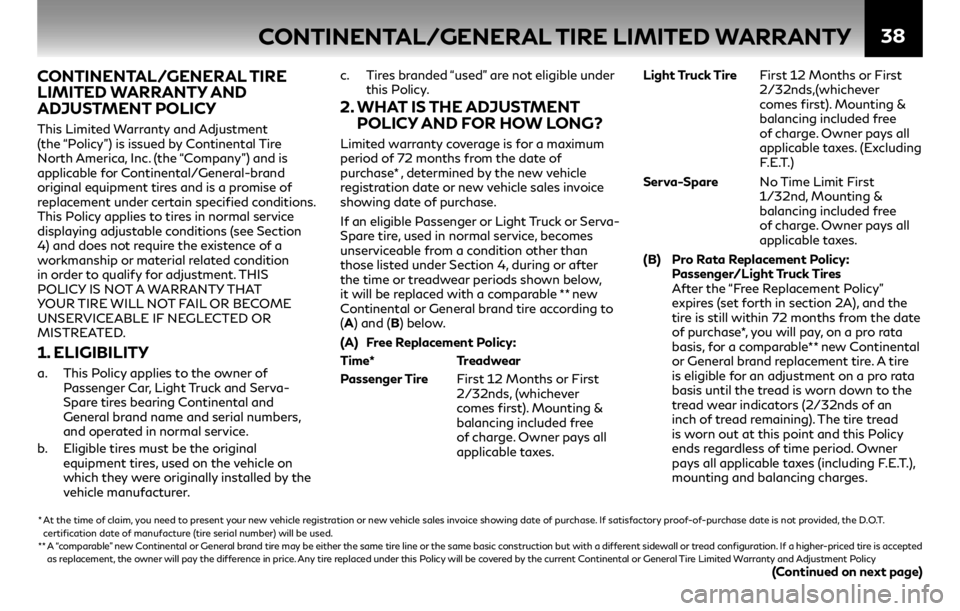
38
CONTINENTAL/GENERAL TIRE
LIMITED WARRANTY AND
ADJUSTMENT POLICY
This Limited Warranty and Adjustment
(the “Policy”) is issued by Continental Tire
North America, Inc. (the “Company”) and is
applicable for Continental/General-brand
original equipment tires and is a promise of
replacement under certain specified conditions.
This Policy applies to tires in normal service
displaying adjustable conditions (see Section
4) and does not require the existence of a
workmanship or material related condition
in order to qualify for adjustment. THIS
POLICY IS NOT A WARRANTY THAT
YOUR TIRE WILL NOT FAIL OR BECOME
UNSERVICEABLE IF NEGLECTED OR
MISTREATED.
1. ELIGIBILITY
a. This Policy applies to the owner of Passenger Car, Light Truck and Serva-
Spare tires bearing Continental and
General brand name and serial numbers,
and operated in normal service.
b. Eligible tires must be the original
equipment tires, used on the vehicle on
which they were originally installed by the
vehicle manufacturer. c. Tires branded “used” are not eligible under
this Policy.
2. WHAT IS THE ADJUSTMENT POLICY AND FOR HOW LONG?
Limited warranty coverage is for a maximum
period of 72 months from the date of
purchase* , determined by the new vehicle
registration date or new vehicle sales invoice
showing date of purchase.
If an eligible Passenger or Light Truck or Serva-
Spare tire, used in normal service, becomes
unserviceable from a condition other than
those listed under Section 4, during or after
the time or treadwear periods shown below,
it will be replaced with a comparable ** new
Continental or General brand tire according to
(A) and (B) below.
(A) Free Replacement Policy:
Time* Treadwear
Passenger Tire First 12 Months or First
2/32nds, (whichever
comes first). Mounting &
balancing included free
of charge. Owner pays all
applicable taxes. Light Truck Tire
First 12 Months or First
2/32nds,(whichever
comes first). Mounting &
balancing included free
of charge. Owner pays all
applicable taxes. (Excluding
F.E.T.)
Serva-Spare No Time Limit First
1/32nd, Mounting &
balancing included free
of charge. Owner pays all
applicable taxes.
(B) Pro Rata Replacement Policy: Passenger/Light Truck Tires
After the “Free Replacement Policy”
expires (set forth in section 2A), and the
tire is still within 72 months from the date
of purchase*, you will pay, on a pro rata
basis, for a comparable** new Continental
or General brand replacement tire. A tire
is eligible for an adjustment on a pro rata
basis until the tread is worn down to the
tread wear indicators (2/32nds of an
inch of tread remaining). The tire tread
is worn out at this point and this Policy
ends regardless of time period. Owner
pays all applicable taxes (including F.E.T.),
mounting and balancing charges.
CONTINENTAL/GENERAL TIRE LIMITED WARRANTY
* At the time of claim, you need to present your new vehicle registration or new vehicle sales invoice showing date of purchase. If satisfactory proof-of-purchase date is not provided, the D.O.T.
certification date of manufacture (tire serial number) will be used.
** A “comparable” new Continental or General brand tire may be either the same tire line or the same basic construction but with a different sidewall or tread configuration. If a higher-priced tire is accepted
as replacement, the owner will pay the difference in price. Any tire replaced under this Policy will be covered by the current Continental or General Tire Limited Warranty and Adjustment Policy
(Continued on next page)
Page 42 of 60
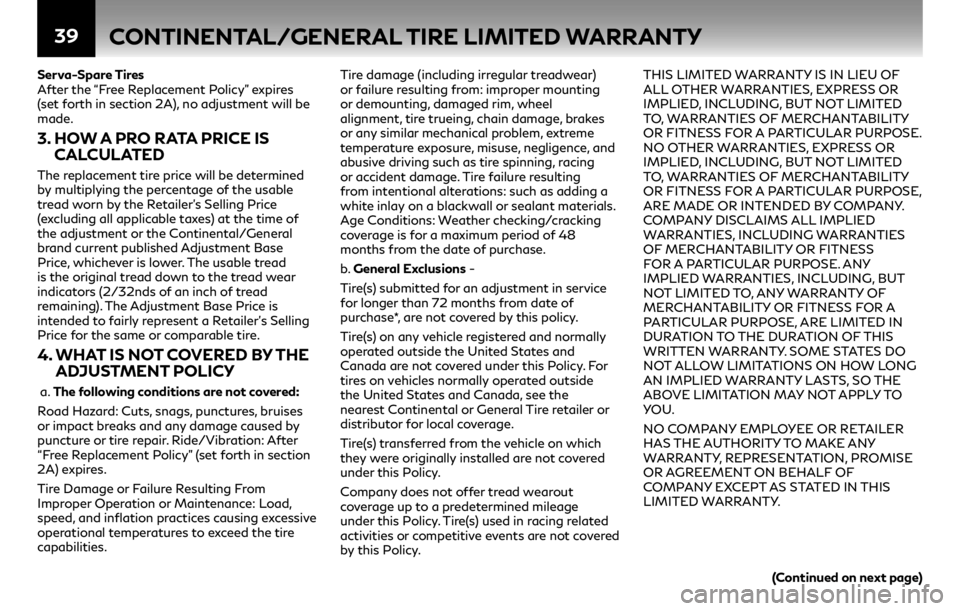
39CONTINENTAL/GENERAL TIRE LIMITED WARRANTY
Serva-Spare Tires
After the “Free Replacement Policy” expires
(set forth in section 2A), no adjustment will be
made.
3. HOW A PRO RATA PRICE IS CALCULATED
The replacement tire price will be determined
by multiplying the percentage of the usable
tread worn by the Retailer’s Selling Price
(excluding all applicable taxes) at the time of
the adjustment or the Continental/General
brand current published Adjustment Base
Price, whichever is lower. The usable tread
is the original tread down to the tread wear
indicators (2/32nds of an inch of tread
remaining). The Adjustment Base Price is
intended to fairly represent a Retailer’s Selling
Price for the same or comparable tire.
4. WHAT IS NOT COVERED BY THE ADJUSTMENT POLICY
a. The following conditions are not covered:
Road Hazard: Cuts, snags, punctures, bruises
or impact breaks and any damage caused by
puncture or tire repair. Ride/Vibration: After
“Free Replacement Policy” (set forth in section
2A) expires.
Tire Damage or Failure Resulting From
Improper Operation or Maintenance: Load,
speed, and inflation practices causing excessive
operational temperatures to exceed the tire
capabilities. Tire damage (including irregular treadwear)
or failure resulting from: improper mounting
or demounting, damaged rim, wheel
alignment, tire trueing, chain damage, brakes
or any similar mechanical problem, extreme
temperature exposure, misuse, negligence, and
abusive driving such as tire spinning, racing
or accident damage. Tire failure resulting
from intentional alterations: such as adding a
white inlay on a blackwall or sealant materials.
Age Conditions: Weather checking/cracking
coverage is for a maximum period of 48
months from the date of purchase.
b.
General Exclusions -
Tire(s) submitted for an adjustment in service
for longer than 72 months from date of
purchase*, are not covered by this policy.
Tire(s) on any vehicle registered and normally
operated outside the United States and
Canada are not covered under this Policy. For
tires on vehicles normally operated outside
the United States and Canada, see the
nearest Continental or General Tire retailer or
distributor for local coverage.
Tire(s) transferred from the vehicle on which
they were originally installed are not covered
under this Policy.
Company does not offer tread wearout
coverage up to a predetermined mileage
under this Policy. Tire(s) used in racing related
activities or competitive events are not covered
by this Policy. THIS LIMITED WARRANTY IS IN LIEU OF
ALL OTHER WARRANTIES, EXPRESS OR
IMPLIED, INCLUDING, BUT NOT LIMITED
TO, WARRANTIES OF MERCHANTABILITY
OR FITNESS FOR A PARTICULAR PURPOSE.
NO OTHER WARRANTIES, EXPRESS OR
IMPLIED, INCLUDING, BUT NOT LIMITED
TO, WARRANTIES OF MERCHANTABILITY
OR FITNESS FOR A PARTICULAR PURPOSE,
ARE MADE OR INTENDED BY COMPANY.
COMPANY DISCLAIMS ALL IMPLIED
WARRANTIES, INCLUDING WARRANTIES
OF MERCHANTABILITY OR FITNESS
FOR A PARTICULAR PURPOSE. ANY
IMPLIED WARRANTIES, INCLUDING, BUT
NOT LIMITED TO, ANY WARRANTY OF
MERCHANTABILITY OR FITNESS FOR A
PARTICULAR PURPOSE, ARE LIMITED IN
DURATION TO THE DURATION OF THIS
WRITTEN WARRANTY. SOME STATES DO
NOT ALLOW LIMITATIONS ON HOW LONG
AN IMPLIED WARRANTY LASTS, SO THE
ABOVE LIMITATION MAY NOT APPLY TO
YOU.
NO COMPANY EMPLOYEE OR RETAILER
HAS THE AUTHORITY TO MAKE ANY
WARRANTY, REPRESENTATION, PROMISE
OR AGREEMENT ON BEHALF OF
COMPANY EXCEPT AS STATED IN THIS
LIMITED WARRANTY.
(Continued on next page)
Page 43 of 60
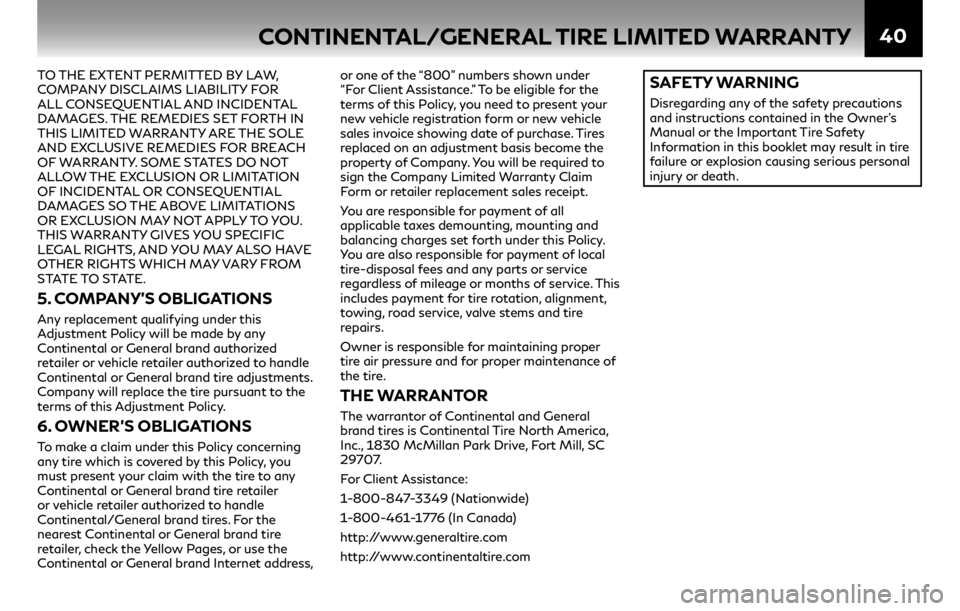
40
TO THE EXTENT PERMITTED BY LAW,
COMPANY DISCLAIMS LIABILITY FOR
ALL CONSEQUENTIAL AND INCIDENTAL
DAMAGES. THE REMEDIES SET FORTH IN
THIS LIMITED WARRANTY ARE THE SOLE
AND EXCLUSIVE REMEDIES FOR BREACH
OF WARRANTY. SOME STATES DO NOT
ALLOW THE EXCLUSION OR LIMITATION
OF INCIDENTAL OR CONSEQUENTIAL
DAMAGES SO THE ABOVE LIMITATIONS
OR EXCLUSION MAY NOT APPLY TO YOU.
THIS WARRANTY GIVES YOU SPECIFIC
LEGAL RIGHTS, AND YOU MAY ALSO HAVE
OTHER RIGHTS WHICH MAY VARY FROM
STATE TO STATE.
5. COMPANY’S OBLIGATIONS
Any replacement qualifying under this
Adjustment Policy will be made by any
Continental or General brand authorized
retailer or vehicle retailer authorized to handle
Continental or General brand tire adjustments.
Company will replace the tire pursuant to the
terms of this Adjustment Policy.
6. OWNER’S OBLIGATIONS
To make a claim under this Policy concerning
any tire which is covered by this Policy, you
must present your claim with the tire to any
Continental or General brand tire retailer
or vehicle retailer authorized to handle
Continental/General brand tires. For the
nearest Continental or General brand tire
retailer, check the Yellow Pages, or use the
Continental or General brand Internet address, or one of the “800” numbers shown under
“For Client Assistance.” To be eligible for the
terms of this Policy, you need to present your
new vehicle registration form or new vehicle
sales invoice showing date of purchase. Tires
replaced on an adjustment basis become the
property of Company. You will be required to
sign the Company Limited Warranty Claim
Form or retailer replacement sales receipt.
You are responsible for payment of all
applicable taxes demounting, mounting and
balancing charges set forth under this Policy.
You are also responsible for payment of local
tire-disposal fees and any parts or service
regardless of mileage or months of service. This
includes payment for tire rotation, alignment,
towing, road service, valve stems and tire
repairs.
Owner is responsible for maintaining proper
tire air pressure and for proper maintenance of
the tire.
THE WARRANTOR
The warrantor of Continental and General
brand tires is Continental Tire North America,
Inc., 1830 McMillan Park Drive, Fort Mill, SC
29707.
For Client Assistance:
1-800-847-3349 (Nationwide)
1-800-461-1776 (In Canada)
http:/
/www.generaltire.com
http:/ /www.continentaltire.com
SAFETY WARNING
Disregarding any of the safety precautions
and instructions contained in the Owner’s
Manual or the Important Tire Safety
Information in this booklet may result in tire
failure or explosion causing serious personal
injury or death.
CONTINENTAL/GENERAL TIRE LIMITED WARRANTY
Page 44 of 60
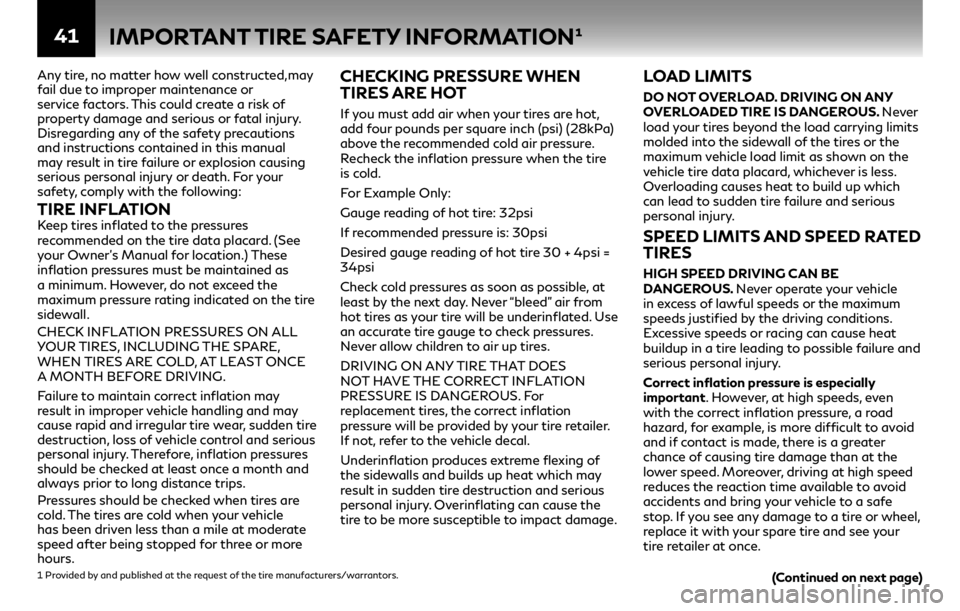
41IMPORTANT TIRE SAFETY INFORMATION¹
Any tire, no matter how well constructed,may
fail due to improper maintenance or
service factors. This could create a risk of
property damage and serious or fatal injury.
Disregarding any of the safety precautions
and instructions contained in this manual
may result in tire failure or explosion causing
serious personal injury or death. For your
safety, comply with the following:
TIRE INFLATION Keep tires inflated to the pressures
recommended on the tire data placard. (See
your Owner’s Manual for location.) These
inflation pressures must be maintained as
a minimum. However, do not exceed the
maximum pressure rating indicated on the tire
sidewall.
CHECK INFLATION PRESSURES ON ALL
YOUR TIRES, INCLUDING THE SPARE,
WHEN TIRES ARE COLD, AT LEAST ONCE
A MONTH BEFORE DRIVING.
Failure to maintain correct inflation may
result in improper vehicle handling and may
cause rapid and irregular tire wear, sudden tire
destruction, loss of vehicle control and serious
personal injury. Therefore, inflation pressures
should be checked at least once a month and
always prior to long distance trips.
Pressures should be checked when tires are
cold. The tires are cold when your vehicle
has been driven less than a mile at moderate
speed after being stopped for three or more
hours.
CHECKING PRESSURE WHEN
TIRES ARE HOT
If you must add air when your tires are hot,
add four pounds per square inch (psi) (28kPa)
above the recommended cold air pressure.
Recheck the inflation pressure when the tire
is cold.
For Example Only:
Gauge reading of hot tire: 32psi
If recommended pressure is: 30psi
Desired gauge reading of hot tire 30 + 4psi =
34psi
Check cold pressures as soon as possible, at
least by the next day. Never “bleed” air from
hot tires as your tire will be underinflated. Use
an accurate tire gauge to check pressures.
Never allow children to air up tires.
DRIVING ON ANY TIRE THAT DOES
NOT HAVE THE CORRECT INFLATION
PRESSURE IS DANGEROUS. For
replacement tires, the correct inflation
pressure will be provided by your tire retailer.
If not, refer to the vehicle decal.
Underinflation produces extreme flexing of
the sidewalls and builds up heat which may
result in sudden tire destruction and serious
personal injury. Overinflating can cause the
tire to be more susceptible to impact damage.
LOAD LIMITS
DO NOT OVERLOAD. DRIVING ON ANY
OVERLOADED TIRE IS DANGEROUS. Never
load your tires beyond the load carrying limits
molded into the sidewall of the tires or the
maximum vehicle load limit as shown on the
vehicle tire data placard, whichever is less.
Overloading causes heat to build up which
can lead to sudden tire failure and serious
personal injury.
SPEED LIMITS AND SPEED RATED
TIRES
HIGH SPEED DRIVING CAN BE
DANGEROUS. Never operate your vehicle
in excess of lawful speeds or the maximum
speeds justified by the driving conditions.
Excessive speeds or racing can cause heat
buildup in a tire leading to possible failure and
serious personal injury.
Correct inflation pressure is especially
important. However, at high speeds, even
with the correct inflation pressure, a road
hazard, for example, is more difficult to avoid
and if contact is made, there is a greater
chance of causing tire damage than at the
lower speed. Moreover, driving at high speed
reduces the reaction time available to avoid
accidents and bring your vehicle to a safe
stop. If you see any damage to a tire or wheel,
replace it with your spare tire and see your
tire retailer at once.
(Continued on next page)1 Provided by and published at the request of the tire manufacturers/warrantors.
Page 45 of 60
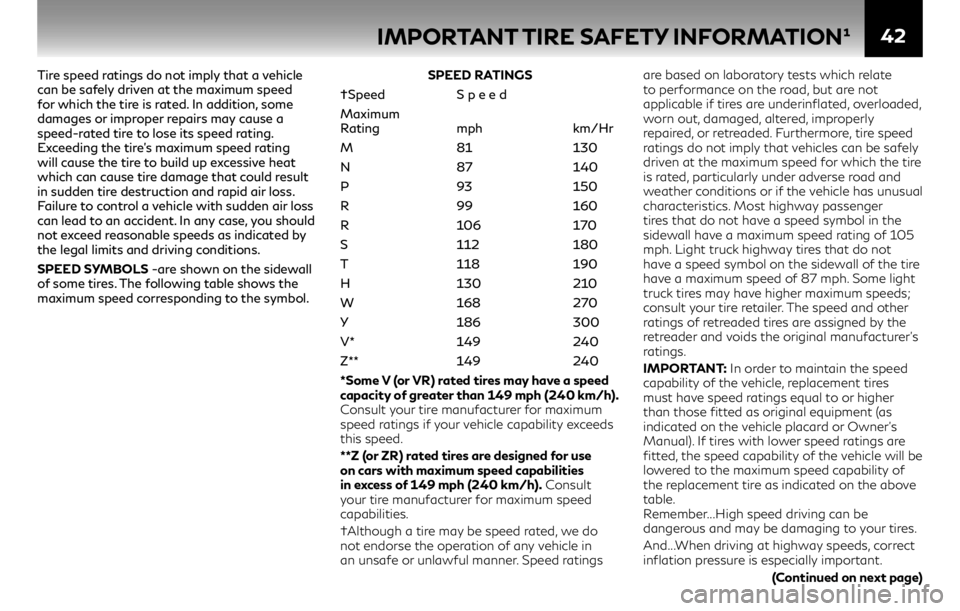
42
Tire speed ratings do not imply that a vehicle
can be safely driven at the maximum speed
for which the tire is rated. In addition, some
damages or improper repairs may cause a
speed-rated tire to lose its speed rating.
Exceeding the tire’s maximum speed rating
will cause the tire to build up excessive heat
which can cause tire damage that could result
in sudden tire destruction and rapid air loss.
Failure to control a vehicle with sudden air loss
can lead to an accident. In any case, you should
not exceed reasonable speeds as indicated by
the legal limits and driving conditions.
SPEED SYMBOLS -are shown on the sidewall
of some tires. The following table shows the
maximum speed corresponding to the symbol.SPEED RATINGS
†Speed S p e e d
Maximum
Rating mph km/Hr
M 81 130
N 87 140
P 93 150
R 99 160
R 106 170
S 112 180
T 118 190
H 130 210
W 168 270
Y 186 300
V* 149 240
Z** 149 240
*Some V (or VR) rated tires may have a speed
capacity of greater than 149 mph (240 km/h).
Consult your tire manufacturer for maximum
speed ratings if your vehicle capability exceeds
this speed.
**Z (or ZR) rated tires are designed for use
on cars with maximum speed capabilities
in excess of 149 mph (240 km/h). Consult
your tire manufacturer for maximum speed
capabilities.
†Although a tire may be speed rated, we do
not endorse the operation of any vehicle in
an unsafe or unlawful manner. Speed ratings are based on laboratory tests which relate
to performance on the road, but are not
applicable if tires are underinflated, overloaded,
worn out, damaged, altered, improperly
repaired, or retreaded. Furthermore, tire speed
ratings do not imply that vehicles can be safely
driven at the maximum speed for which the tire
is rated, particularly under adverse road and
weather conditions or if the vehicle has unusual
characteristics. Most highway passenger
tires that do not have a speed symbol in the
sidewall have a maximum speed rating of 105
mph. Light truck highway tires that do not
have a speed symbol on the sidewall of the tire
have a maximum speed of 87 mph. Some light
truck tires may have higher maximum speeds;
consult your tire retailer. The speed and other
ratings of retreaded tires are assigned by the
retreader and voids the original manufacturer’s
ratings.
IMPORTANT:
In order to maintain the speed
capability of the vehicle, replacement tires
must have speed ratings equal to or higher
than those fitted as original equipment (as
indicated on the vehicle placard or Owner’s
Manual). If tires with lower speed ratings are
fitted, the speed capability of the vehicle will be
lowered to the maximum speed capability of
the replacement tire as indicated on the above
table.
Remember...High speed driving can be
dangerous and may be damaging to your tires.
And...When driving at highway speeds, correct
inflation pressure is especially important.
(Continued on next page)
IMPORTANT TIRE SAFETY INFORMATION¹
Page 46 of 60
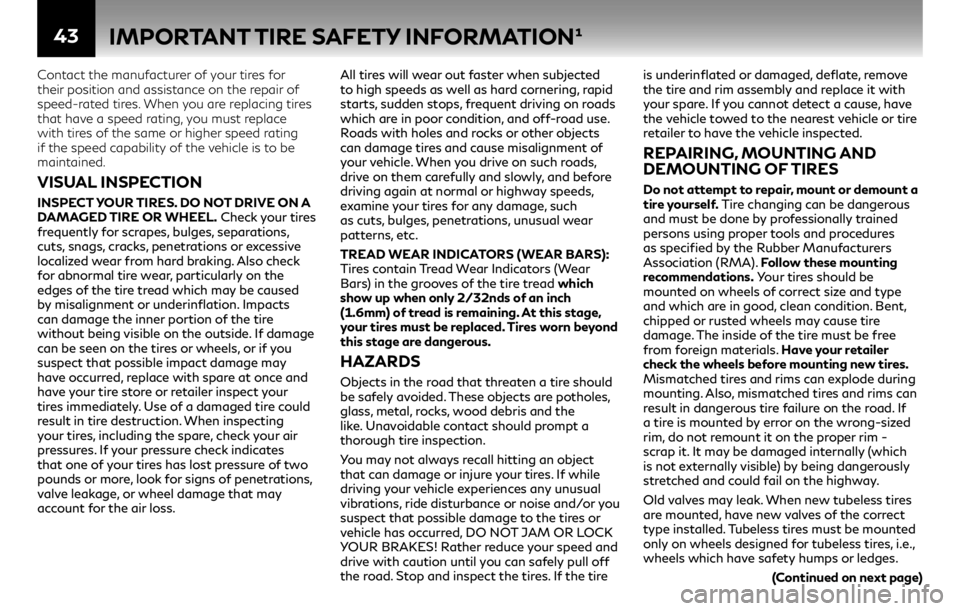
43
Contact the manufacturer of your tires for
their position and assistance on the repair of
speed-rated tires. When you are replacing tires
that have a speed rating, you must replace
with tires of the same or higher speed rating
if the speed capability of the vehicle is to be
maintained.
VISUAL INSPECTION
INSPECT YOUR TIRES. DO NOT DRIVE ON A
DAMAGED TIRE OR WHEEL. Check your tires
frequently for scrapes, bulges, separations,
cuts, snags, cracks, penetrations or excessive
localized wear from hard braking. Also check
for abnormal tire wear, particularly on the
edges of the tire tread which may be caused
by misalignment or underinflation. Impacts
can damage the inner portion of the tire
without being visible on the outside. If damage
can be seen on the tires or wheels, or if you
suspect that possible impact damage may
have occurred, replace with spare at once and
have your tire store or retailer inspect your
tires immediately. Use of a damaged tire could
result in tire destruction. When inspecting
your tires, including the spare, check your air
pressures. If your pressure check indicates
that one of your tires has lost pressure of two
pounds or more, look for signs of penetrations,
valve leakage, or wheel damage that may
account for the air loss.All tires will wear out faster when subjected
to high speeds as well as hard cornering, rapid
starts, sudden stops, frequent driving on roads
which are in poor condition, and off-road use.
Roads with holes and rocks or other objects
can damage tires and cause misalignment of
your vehicle. When you drive on such roads,
drive on them carefully and slowly, and before
driving again at normal or highway speeds,
examine your tires for any damage, such
as cuts, bulges, penetrations, unusual wear
patterns, etc.
TREAD WEAR INDICATORS (WEAR BARS):
Tires contain Tread Wear Indicators (Wear
Bars) in the grooves of the tire tread which
show up when only 2/32nds of an inch
(1.6mm) of tread is remaining. At this stage,
your tires must be replaced. Tires worn beyond
this stage are dangerous.
HAZARDS
Objects in the road that threaten a tire should
be safely avoided. These objects are potholes,
glass, metal, rocks, wood debris and the
like. Unavoidable contact should prompt a
thorough tire inspection.
You may not always recall hitting an object
that can damage or injure your tires. If while
driving your vehicle experiences any unusual
vibrations, ride disturbance or noise and/or you
suspect that possible damage to the tires or
vehicle has occurred, DO NOT JAM OR LOCK
YOUR BRAKES! Rather reduce your speed and
drive with caution until you can safely pull off
the road. Stop and inspect the tires. If the tire is underinflated or damaged, deflate, remove
the tire and rim assembly and replace it with
your spare. If you cannot detect a cause, have
the vehicle towed to the nearest vehicle or tire
retailer to have the vehicle inspected.
REPAIRING, MOUNTING AND
DEMOUNTING OF TIRES
Do not attempt to repair, mount or demount a
tire yourself. Tire changing can be dangerous
and must be done by professionally trained
persons using proper tools and procedures
as specified by the Rubber Manufacturers
Association (RMA). Follow these mounting
recommendations. Your tires should be
mounted on wheels of correct size and type
and which are in good, clean condition. Bent,
chipped or rusted wheels may cause tire
damage. The inside of the tire must be free
from foreign materials. Have your retailer
check the wheels before mounting new tires.
Mismatched tires and rims can explode during
mounting. Also, mismatched tires and rims can
result in dangerous tire failure on the road. If
a tire is mounted by error on the wrong-sized
rim, do not remount it on the proper rim -
scrap it. It may be damaged internally (which
is not externally visible) by being dangerously
stretched and could fail on the highway.
Old valves may leak. When new tubeless tires
are mounted, have new valves of the correct
type installed. Tubeless tires must be mounted
only on wheels designed for tubeless tires, i.e.,
wheels which have safety humps or ledges.
IMPORTANT TIRE SAFETY INFORMATION¹
(Continued on next page)
Page 47 of 60
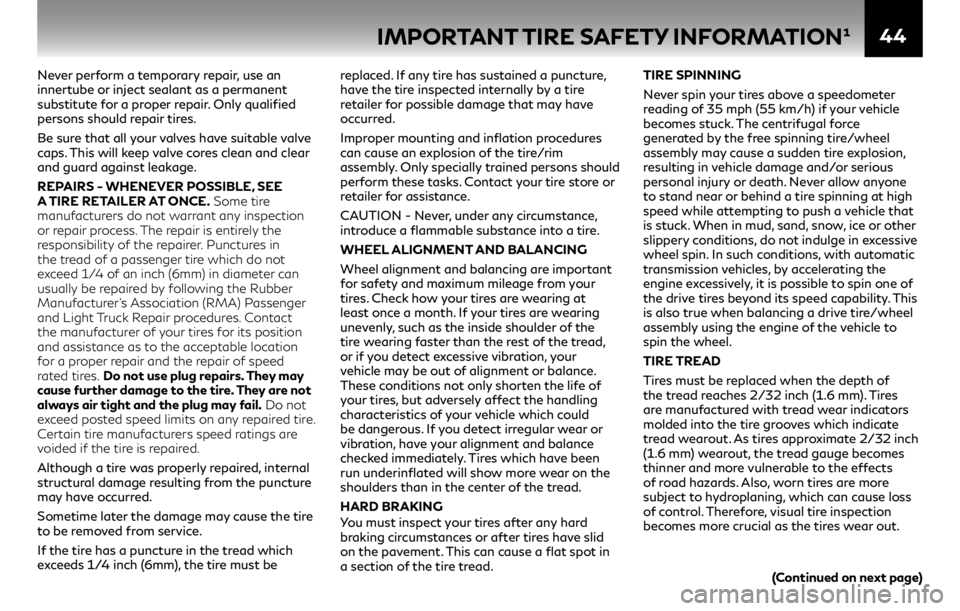
44
Never perform a temporary repair, use an
innertube or inject sealant as a permanent
substitute for a proper repair. Only qualified
persons should repair tires.
Be sure that all your valves have suitable valve
caps. This will keep valve cores clean and clear
and guard against leakage.
REPAIRS - WHENEVER POSSIBLE, SEE
A TIRE RETAILER AT ONCE.Some tire
manufacturers do not warrant any inspection
or repair process. The repair is entirely the
responsibility of the repairer. Punctures in
the tread of a passenger tire which do not
exceed 1/4 of an inch (6mm) in diameter can
usually be repaired by following the Rubber
Manufacturer’s Association (RMA) Passenger
and Light Truck Repair procedures. Contact
the manufacturer of your tires for its position
and assistance as to the acceptable location
for a proper repair and the repair of speed
rated tires. Do not use plug repairs. They may
cause further damage to the tire. They are not
always air tight and the plug may fail. Do not
exceed posted speed limits on any repaired tire.
Certain tire manufacturers speed ratings are
voided if the tire is repaired.
Although a tire was properly repaired, internal
structural damage resulting from the puncture
may have occurred.
Sometime later the damage may cause the tire
to be removed from service.
If the tire has a puncture in the tread which
exceeds 1/4 inch (6mm), the tire must be replaced. If any tire has sustained a puncture,
have the tire inspected internally by a tire
retailer for possible damage that may have
occurred.
Improper mounting and inflation procedures
can cause an explosion of the tire/rim
assembly. Only specially trained persons should
perform these tasks. Contact your tire store or
retailer for assistance.
CAUTION - Never, under any circumstance,
introduce a flammable substance into a tire.
WHEEL ALIGNMENT AND BALANCING
Wheel alignment and balancing are important
for safety and maximum mileage from your
tires. Check how your tires are wearing at
least once a month. If your tires are wearing
unevenly, such as the inside shoulder of the
tire wearing faster than the rest of the tread,
or if you detect excessive vibration, your
vehicle may be out of alignment or balance.
These conditions not only shorten the life of
your tires, but adversely affect the handling
characteristics of your vehicle which could
be dangerous. If you detect irregular wear or
vibration, have your alignment and balance
checked immediately. Tires which have been
run underinflated will show more wear on the
shoulders than in the center of the tread.
HARD BRAKING
You must inspect your tires after any hard
braking circumstances or after tires have slid
on the pavement. This can cause a flat spot in
a section of the tire tread. TIRE SPINNING
Never spin your tires above a speedometer
reading of 35 mph (55 km/h) if your vehicle
becomes stuck. The centrifugal force
generated by the free spinning tire/wheel
assembly may cause a sudden tire explosion,
resulting in vehicle damage and/or serious
personal injury or death. Never allow anyone
to stand near or behind a tire spinning at high
speed while attempting to push a vehicle that
is stuck. When in mud, sand, snow, ice or other
slippery conditions, do not indulge in excessive
wheel spin. In such conditions, with automatic
transmission vehicles, by accelerating the
engine excessively, it is possible to spin one of
the drive tires beyond its speed capability. This
is also true when balancing a drive tire/wheel
assembly using the engine of the vehicle to
spin the wheel.
TIRE TREAD
Tires must be replaced when the depth of
the tread reaches 2/32 inch (1.6 mm). Tires
are manufactured with tread wear indicators
molded into the tire grooves which indicate
tread wearout. As tires approximate 2/32 inch
(1.6 mm) wearout, the tread gauge becomes
thinner and more vulnerable to the effects
of road hazards. Also, worn tires are more
subject to hydroplaning, which can cause loss
of control. Therefore, visual tire inspection
becomes more crucial as the tires wear out.
(Continued on next page)
IMPORTANT TIRE SAFETY INFORMATION¹
Page 48 of 60
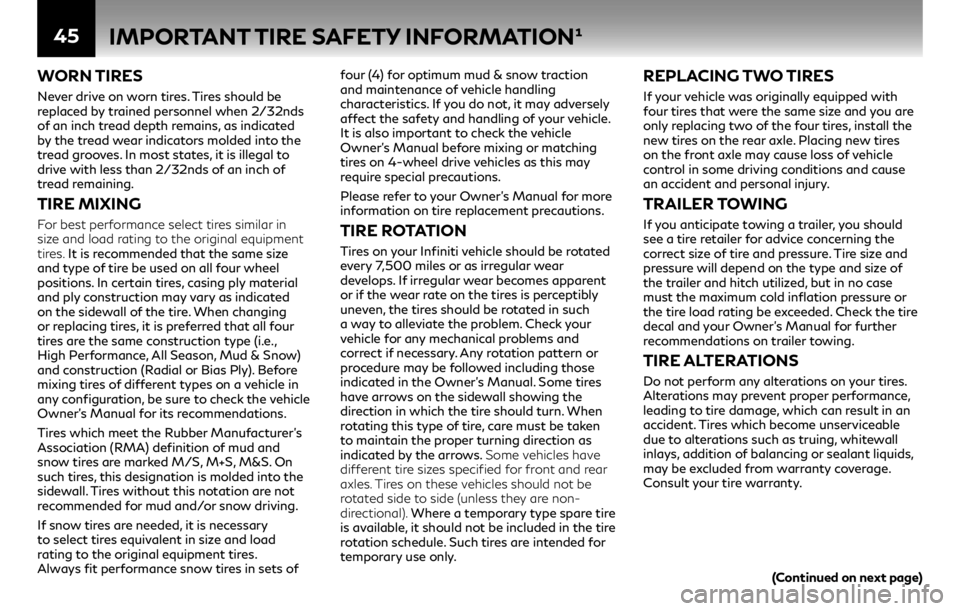
45
WORN TIRES
Never drive on worn tires. Tires should be
replaced by trained personnel when 2/32nds
of an inch tread depth remains, as indicated
by the tread wear indicators molded into the
tread grooves. In most states, it is illegal to
drive with less than 2/32nds of an inch of
tread remaining.
TIRE MIXING
For best performance select tires similar in
size and load rating to the original equipment
tires. It is recommended that the same size
and type of tire be used on all four wheel
positions. In certain tires, casing ply material
and ply construction may vary as indicated
on the sidewall of the tire. When changing
or replacing tires, it is preferred that all four
tires are the same construction type (i.e.,
High Performance, All Season, Mud & Snow)
and construction (Radial or Bias Ply). Before
mixing tires of different types on a vehicle in
any configuration, be sure to check the vehicle
Owner’s Manual for its recommendations.
Tires which meet the Rubber Manufacturer’s
Association (RMA) definition of mud and
snow tires are marked M/S, M+S, M&S. On
such tires, this designation is molded into the
sidewall. Tires without this notation are not
recommended for mud and/or snow driving.
If snow tires are needed, it is necessary
to select tires equivalent in size and load
rating to the original equipment tires.
Always fit performance snow tires in sets of four (4) for optimum mud & snow traction
and maintenance of vehicle handling
characteristics. If you do not, it may adversely
affect the safety and handling of your vehicle.
It is also important to check the vehicle
Owner’s Manual before mixing or matching
tires on 4-wheel drive vehicles as this may
require special precautions.
Please refer to your Owner’s Manual for more
information on tire replacement precautions. TIRE ROTATION
Tires on your Infiniti vehicle should be rotated
every 7,500 miles or as irregular wear
develops. If irregular wear becomes apparent
or if the wear rate on the tires is perceptibly
uneven, the tires should be rotated in such
a way to alleviate the problem. Check your
vehicle for any mechanical problems and
correct if necessary. Any rotation pattern or
procedure may be followed including those
indicated in the Owner’s Manual. Some tires
have arrows on the sidewall showing the
direction in which the tire should turn. When
rotating this type of tire, care must be taken
to maintain the proper turning direction as
indicated by the arrows. Some vehicles have
different tire sizes specified for front and rear
axles. Tires on these vehicles should not be
rotated side to side (unless they are non-
directional). Where a temporary type spare tire
is available, it should not be included in the tire
rotation schedule. Such tires are intended for
temporary use only.
REPLACING TWO TIRES
If your vehicle was originally equipped with
four tires that were the same size and you are
only replacing two of the four tires, install the
new tires on the rear axle. Placing new tires
on the front axle may cause loss of vehicle
control in some driving conditions and cause
an accident and personal injury.
TRAILER TOWING
If you anticipate towing a trailer, you should
see a tire retailer for advice concerning the
correct size of tire and pressure. Tire size and
pressure will depend on the type and size of
the trailer and hitch utilized, but in no case
must the maximum cold inflation pressure or
the tire load rating be exceeded. Check the tire
decal and your Owner’s Manual for further
recommendations on trailer towing.
TIRE ALTERATIONS
Do not perform any alterations on your tires.
Alterations may prevent proper performance,
leading to tire damage, which can result in an
accident. Tires which become unserviceable
due to alterations such as truing, whitewall
inlays, addition of balancing or sealant liquids,
may be excluded from warranty coverage.
Consult your tire warranty.
(Continued on next page)
IMPORTANT TIRE SAFETY INFORMATION¹
Page 49 of 60
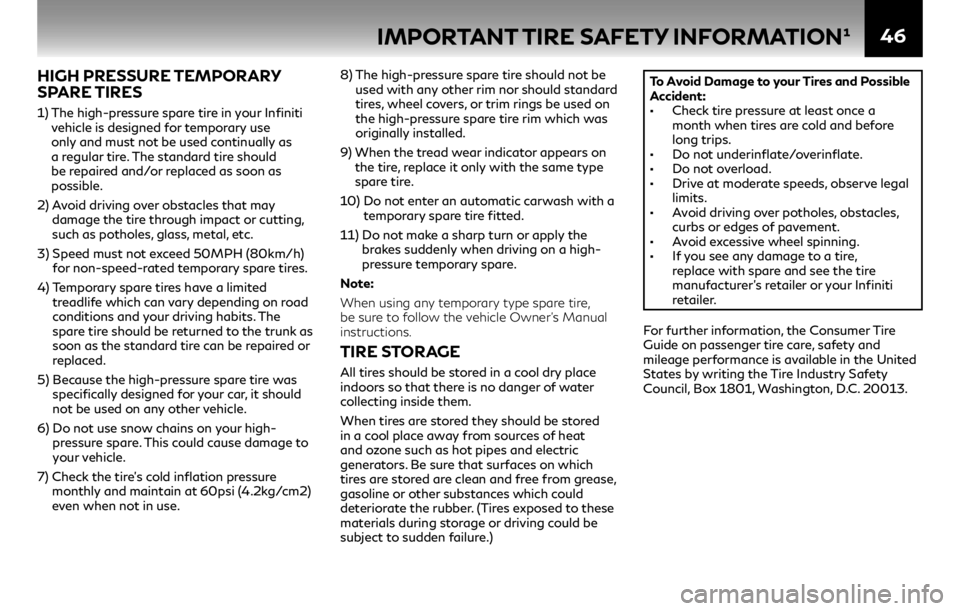
46
HIGH PRESSURE TEMPORARY
SPARE TIRES
1) The high-pressure spare tire in your Infiniti
vehicle is designed for temporary use
only and must not be used continually as
a regular tire. The standard tire should
be repaired and/or replaced as soon as
possible.
2) Avoid driving over obstacles that may
damage the tire through impact or cutting,
such as potholes, glass, metal, etc.
3) Speed must not exceed 50MPH (80km/h) for non-speed-rated temporary spare tires.
4) Temporary spare tires have a limited
treadlife which can vary depending on road
conditions and your driving habits. The
spare tire should be returned to the trunk as
soon as the standard tire can be repaired or
replaced.
5) Because the high-pressure spare tire was specifically designed for your car, it should
not be used on any other vehicle.
6) Do not use snow chains on your high-
pressure spare. This could cause damage to
your vehicle.
7) Check the tire’s cold inflation pressure monthly and maintain at 60psi (4.2kg/cm2)
even when not in use. 8)
The high-pressure spare tire should not be
used with any other rim nor should standard
tires, wheel covers, or trim rings be used on
the high-pressure spare tire rim which was
originally installed.
9) When the tread wear indicator appears on
the tire, replace it only with the same type
spare tire.
10) Do not enter an automatic carwash with a
temporary spare tire fitted.
11) Do not make a sharp turn or apply the brakes suddenly when driving on a high-
pressure temporary spare.
Note:
When using any temporary type spare tire,
be sure to follow the vehicle Owner’s Manual
instructions.
TIRE STORAGE
All tires should be stored in a cool dry place
indoors so that there is no danger of water
collecting inside them.
When tires are stored they should be stored
in a cool place away from sources of heat
and ozone such as hot pipes and electric
generators. Be sure that surfaces on which
tires are stored are clean and free from grease,
gasoline or other substances which could
deteriorate the rubber. (Tires exposed to these
materials during storage or driving could be
subject to sudden failure.) To Avoid Damage to your Tires and Possible
Accident:
•• Check tire pressure at least once a
month when tires are cold and before
long trips.
•• Do not underinflate/overinflate.•• Do not overload.•• Drive at moderate speeds, observe legal limits.
•• Avoid driving over potholes, obstacles, curbs or edges of pavement.
•• Avoid excessive wheel spinning.•• If you see any damage to a tire, replace with spare and see the tire
manufacturer’s retailer or your Infiniti
retailer.
For further information, the Consumer Tire
Guide on passenger tire care, safety and
mileage performance is available in the United
States by writing the Tire Industry Safety
Council, Box 1801, Washington, D.C. 20013.
IMPORTANT TIRE SAFETY INFORMATION¹
Page 50 of 60
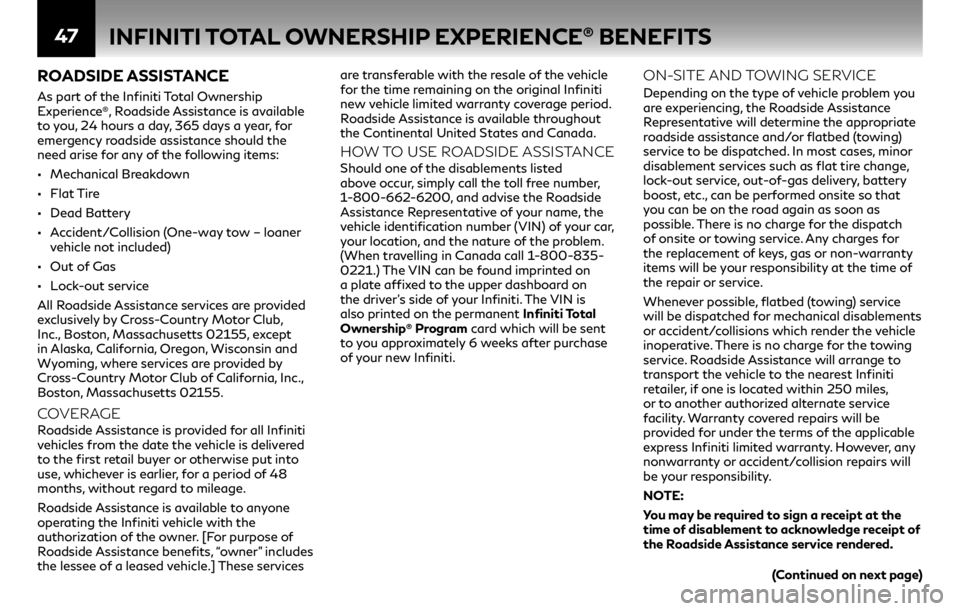
47INFINITI TOTAL OWNERSHIP EXPERIENCE® BENEFITS
ROADSIDE ASSISTANCE
As part of the Infiniti Total Ownership
Experience®, Roadside Assistance is available
to you, 24 hours a day, 365 days a year, for
emergency roadside assistance should the
need arise for any of the following items:
•• Mechanical Breakdown
•• Flat Tire
•• Dead Battery
•• Accident/Collision (One-way tow – loaner vehicle not included)
•• Out of Gas
•• Lock-out service
All Roadside Assistance services are provided
exclusively by Cross-Country Motor Club,
Inc., Boston, Massachusetts 02155, except
in Alaska, California, Oregon, Wisconsin and
Wyoming, where services are provided by
Cross-Country Motor Club of California, Inc.,
Boston, Massachusetts 02155.
COVERAGE Roadside Assistance is provided for all Infiniti
vehicles from the date the vehicle is delivered
to the first retail buyer or otherwise put into
use, whichever is earlier, for a period of 48
months, without regard to mileage.
Roadside Assistance is available to anyone
operating the Infiniti vehicle with the
authorization of the owner. [For purpose of
Roadside Assistance benefits, “owner” includes
the lessee of a leased vehicle.] These services are transferable with the resale of the vehicle
for the time remaining on the original Infiniti
new vehicle limited warranty coverage period.
Roadside Assistance is available throughout
the Continental United States and Canada.
HOW TO USE ROADSIDE ASSISTANCE Should one of the disablements listed
above occur, simply call the toll free number,
1-800-662-6200, and advise the Roadside
Assistance Representative of your name, the
vehicle identification number (VIN) of your car,
your location, and the nature of the problem.
(When travelling in Canada call 1-800-835-
0221.) The VIN can be found imprinted on
a plate affixed to the upper dashboard on
the driver’s side of your Infiniti. The VIN is
also printed on the permanent
Infiniti Total
Ownership
® Program card which will be sent
to you approximately 6 weeks after purchase
of your new Infiniti.
ON-SITE AND TOWING SERVICE
Depending on the type of vehicle problem you
are experiencing, the Roadside Assistance
Representative will determine the appropriate
roadside assistance and/or flatbed (towing)
service to be dispatched. In most cases, minor
disablement services such as flat tire change,
lock-out service, out-of-gas delivery, battery
boost, etc., can be performed onsite so that
you can be on the road again as soon as
possible. There is no charge for the dispatch
of onsite or towing service. Any charges for
the replacement of keys, gas or non-warranty
items will be your responsibility at the time of
the repair or service.
Whenever possible, flatbed (towing) service
will be dispatched for mechanical disablements
or accident/collisions which render the vehicle
inoperative. There is no charge for the towing
service. Roadside Assistance will arrange to
transport the vehicle to the nearest Infiniti
retailer, if one is located within 250 miles,
or to another authorized alternate service
facility. Warranty covered repairs will be
provided for under the terms of the applicable
express Infiniti limited warranty. However, any
nonwarranty or accident/collision repairs will
be your responsibility.
NOTE:
You may be required to sign a receipt at the
time of disablement to acknowledge receipt of
the Roadside Assistance service rendered.
(Continued on next page)